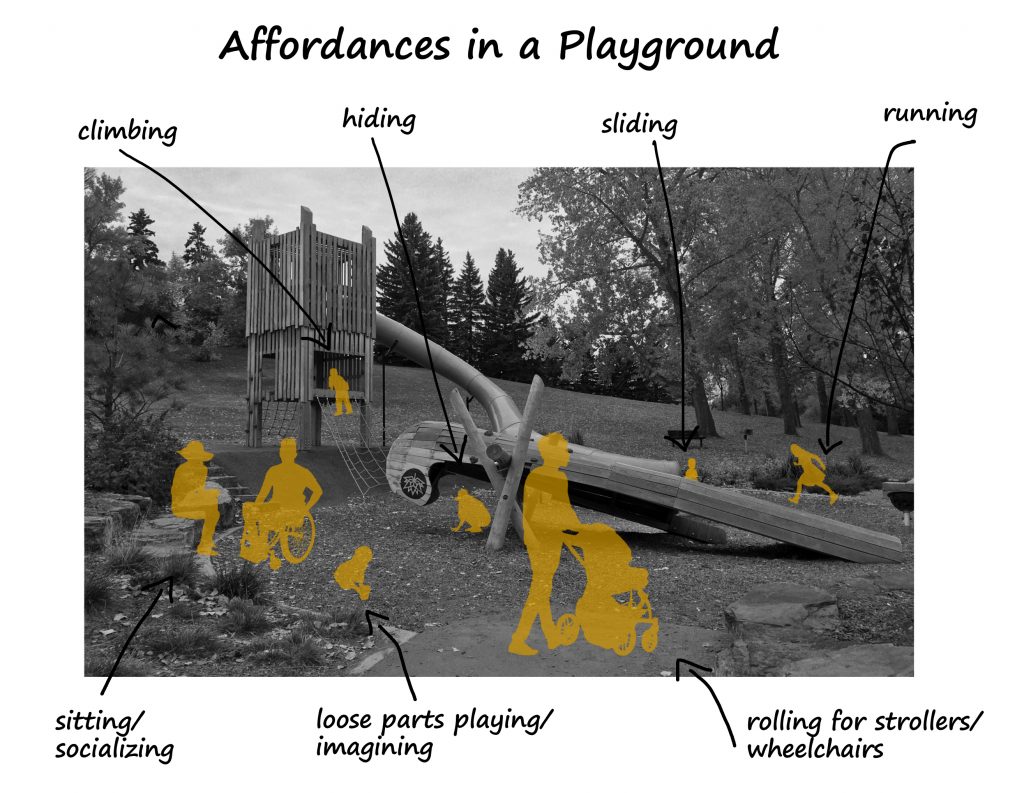Affordances
Miho Trudeau
Miho Trudeau is a PhD Candidate with the School of Architecture, Planning and Landscape at the University of Calgary. Her doctoral research explores people’s experiences with the development and usage of natural playgrounds in Calgary, Alberta.
Possibilities for play: Annotating affordances in a playground
The different ways that an environment, or an element within an environment, can be used are called affordances. For instance, if there is a declining flat surface in an environment, such as a ramp, that environment has a rolling affordance. What we are able to experience in an environment is dependent on both it and us, the user. For example, a bench of a certain height could be used to sit on or hide beneath; however, the ability to do these actions is also dependent on the individual. A very high bench may not allow a small child to sit on it, while a taller person may not be able to hide beneath it. Moreover, social and cultural contexts may affect how a person uses a bench. For example, although a person may wish to jump and walk on a bench, social norms may deem this as unacceptable behaviour, which may inhibit the bench from being used in that way. In this way, affordances are dependent on the environment, the user, and other contextual socio-cultural factors.
Children’s play environments, such as playgrounds, are often assessed for the different affordances that they offer children. Rather than looking at the different structures within a playground, sites can be analyzed for the different use functions, or affordances, present within the site. For example, a site can be analyzed for physical affordances (e.g., climbing, jumping), social affordances (e.g., cooperative play opportunities), creative and constructive play affordances (e.g., building with sand or other loose materials), and others—the list goes on and on. Below is an example of a playground that is annotated with diverse affordances offered to users. Note that these annotated affordances are dependent on a user’s subjectivity; for example, if a playground has a climbing structure, climbing is only available as an affordance for those with that physical capability. When considering the affordances within a site such as a playground, it is important to consider who the users are and how contextual factors may also have an impact. For example, what are the affordances of a playground such as this if the primary users have physical disabilities or if the playground is situated within a community with high crime and vandalism rates?

Perception is also a significant factor within affordances. How a user perceives an affordance within an environment will affect the actualization of the affordance, that is whether the perceived use function is carried out by a user. For example, within the playground, the slide and the rope ladder are relatively easy to perceive by most users, meaning that they will likely become actualized affordances. Other structures, such as the rock boulders, are less evident in their potential use, and might be used for sitting or for more active play, such as jumping or climbing. Given their ambiguity, less structured affordances invite more diverse interpretations, enabling children to feel more comfortable playing on them than, for example, on a bench. Similarly, affordances that allow for diverse interpretations may lead caregivers to feel more comfortable than, for example, sitting inside a play space or on a clearly demarcated play structure such as a climber.
Discussion Questions
- What kinds of sociocultural constraints might have an impact on a site’s affordances? Compare and contrast two public spaces in different geographical contexts and describe the possible sociocultural constraints that may impact the affordances of these two sites.
- Why is it important for designers to consider a diversity of users when reflecting on the affordances of a site? Think of some examples wherein diverse users are not considered within site design and how that affects site affordances.
- Can you think of some general ways that affordances can be maximized within a site?
- Choose an object in your home or everyday life (e.g. a specific kitchen or home appliance) and list the diverse affordances of that object. Is the use of the object easy to perceive? What are some of the ways that the design of the object makes it easy or difficult to use?
Exercise
Visit a nearby public space and take a photo. Try to ensure that your photo does not include identifiable people who may not want to be photographed. You can also blur people’s faces afterwards to protect their anonymity. Observe and note the site’s usage for a short period of time. Later, annotate the photo with the observed and potential affordances of the site.
Additional Readings
Chemero, A. (2003). An outline of a theory of affordances. Ecological Psychology 15 (2): 181–95.
Gibson, J. J. (1979). The ecological approach to visual perception. Boston: Houghton Mifflin.
Heft, H. (1988). Affordances of children’s environments: A functional approach to environmental description. Children’s Environments Quarterly 5 (3): 29–37.
Kyttä, M. (2004). The extent of children’s independent mobility and the number of actualized affordances as criteria for child-friendly environments. Journal of Environmental Psychology 24 (2): 179–98.
Maier, J.R.A.,Fadel, G.M., and Battisto, D.G. (2009). An affordance-based approach to architectural theory, design, and practice. Design Studies 30 (4): 393–414.
Norman, D. A. (1999). Affordance, conventions, and design. Interactions 6 (3): 38–43.
Norman, D.A. (2013). The design of everyday things. New York: Basic Books; Revised and expanded edition.
Rietveld, E., and Kiverstein, J. (2014). A rich landscape of affordances. Ecological Psychology 26 (4): 325–52.
Udacity. Definition: Affordance – Intro to the Design of Everyday Things https://www.youtube.com/watch?v=a6F0EYCUjcE

